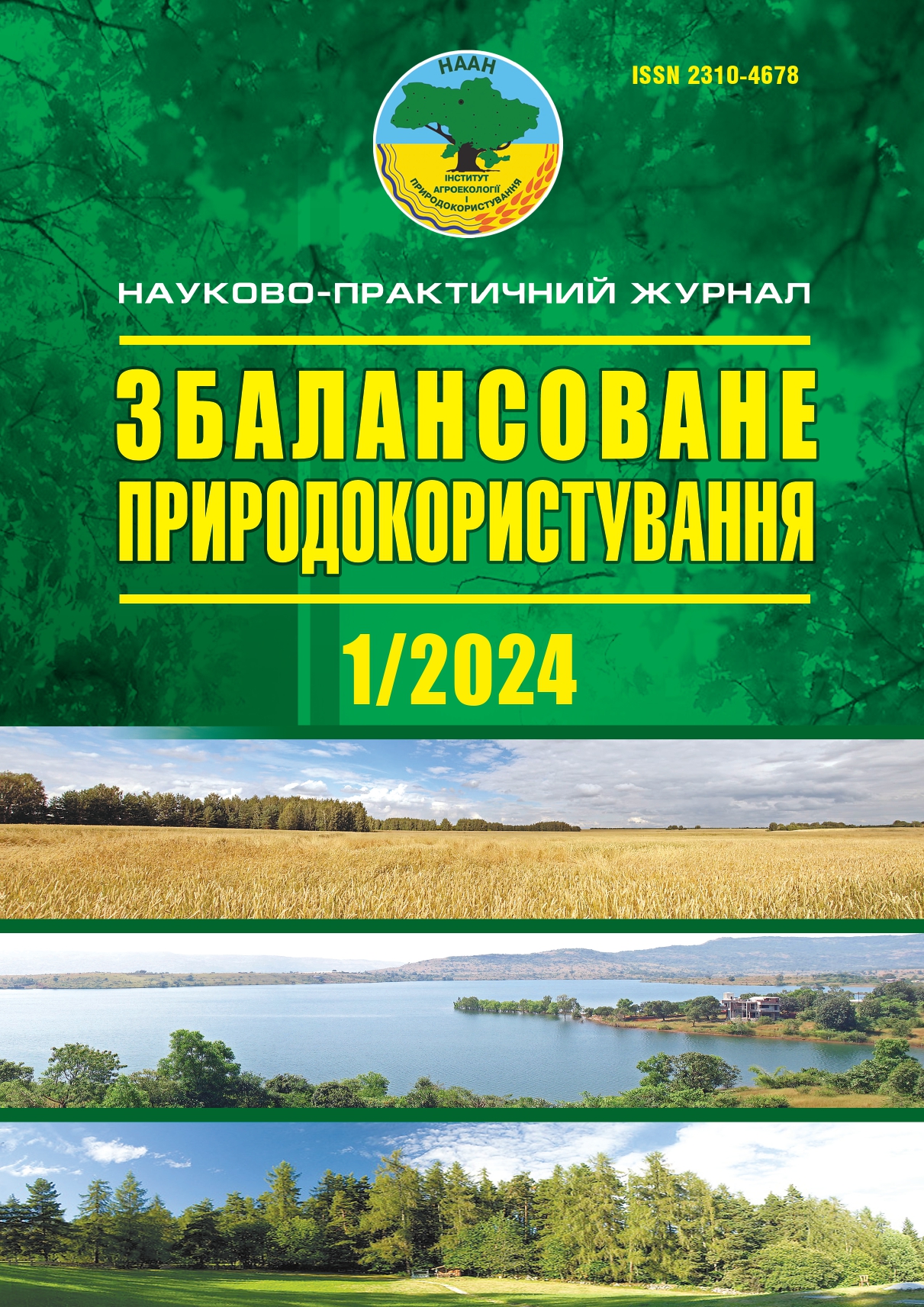Наукові основи оптимізації використання й охорони земель в умовах дії водної та вітрової ерозій
DOI:
https://doi.org/10.33730/2310-4678.1.2024.302613Ключові слова:
захист земель, лісові, полезахисні насадження, агротехніка, деградація грунтового покривуАнотація
У статті висвітлено обґрунтування теоретико-методологічних засад оптимізації використання та охорони земель в умовах дії водної та вітрової ерозій. Сформовано методичні підходи щодо створення інформаційної бази для регіонального виокремлення земель гіршої якості, які можуть бути інвестиційно привабливими для несільськогосподарського використання. Обґрунтовано, що одним із головних чинників дестабілізації екологічної ситуації в сільськогосподарському землекористуванні є надмірна сільськогосподарська освоєність і розораність території, зокрема в зонах Степу та Лісостепу. Ці процеси не мали ні економічного, ні екологічного обґрунтування щодо збалансованості структури земельних угідь як загалом в Україні, так і в регіональних формуваннях. Набувають подальшого розвитку деградаційні процеси, які нелокалізовані та стають загрозливим явищем. Особливо посилюється дія водної та вітрової ерозій, що мають чітко виражений регіональний характер. Для зони Степу суттєвим чинником, що призводить до зменшення розвитку як водної, так і вітрової ерозії, є різні методи максимуму проективного покриття штучних агроценозів (липень–серпень) та пік зливової активності (травень–червень). У таких умовах ґрунтовий покрив найбільш піддатливий до негативної дії ерозійних процесів, що значно посилює деградацію земель і знижує продуктивну спроможність земельних ресурсів. Указане обумовлює необхідність системного підходу до розроблення комплексу протиерозійних заходів і здійснення їх із застосуванням як економічного стимулювання, так і відповідних штрафних санкцій. У статті приділяється значна увага підвищенню продуктивності землеробства на основі застосування високоефективних заходів щодо захисту і зберігання екологічної рівноваги в навколишньому середовищі. Зокрема, переходу на контурно-меліоративну організацію території, яка передбачає диференціацію використання орних земель за відповідними технологічними параметрами (ухил в град. схилів) та екологічними даними (площинний змив у т/га), дає можливість не тільки зберегти ґрунти від деградації, але й на 10–15% підвищити продуктивність полів (3,0 тис. га). Упровадження ресурсо- та енергозберігаючих технологій протиерозійного обробітку ґрунту забезпечує розширене відтворення ґрунтової родючості. Велике значення в боротьбі з водною ерозією надається різним гідротехнічним спорудам (швидкотокам, валам, валам-терасам, валам-каналам) та полезахисним лісосмугам (поздовжнім і поперечним).
Посилання
Babmindra, D.I. (2002). Kryzovi yavyshcha u silskohospodarskomu zemlekorystuvanni (teoriia, metodolohiia, praktyka) [Crisis phenomena in agricultural land use (theory, methodology, practice)]. Problems of the development of land relations on the basis of the new Land Code of Ukraine ’02: materialy Vseukrainskoi naukovoi konferentsii — materials of the All-Ukrainian scientific conference (pp. 124–125). K.: Land Management Institute of NAAS [Ukrainian].
Bulyhin, S.Yu. (2005). Formuvannia ekolohichno stalykh ahrolandshaftiv: pidruchnyk [Formation of ecologically sustainable agrolandscapes: a Textbook]. K.: Urozhai [in Ukrainian].
Dobriak, D.S., Babmindra, D.I. (2006). Ekoloho-ekonomichni zasady reformuvannia zemlekorystuvannia v rynkovykh umovakh: monohrafiia [Ecological and economic principles of land use reform in market conditions: monograph]. K.: Urozhai [in Ukrainian].
Dobriak, D.S., Chernitskyi, O.Z. (2005). Modernizatsiia ekoloho-ekonomichnoho mekhanizmu zakhystu zemelnykh resursiv vid dehradatsiinykh protsesiv [Modernization of the ecological and economic mechanism for the protection of land resources from degradation processes]. Management of land resources in the context of sustainable development strategy ’05: materialy kruhloho stolu — materials of the round table (pp. 109–170). K.: NAAN [in Ukrainian].
Drebot, O.I., Dobriak, D.S., Melnyk, P.P. (2020). Naukovi zasady vidtvorennia produktyvnosti dehradovanykh i maloproduktyvnykh zemel [Scientific principles of reproducing the productivity of degraded and unproductive lands]. Zbalansovane pryrodokorystuvannia — Balanced nature management, 2, 5–17. DOI: https://doi.org/10.33730/2310-4678.2.2020.208760 [in Ukrainian].
Martyn, A.H., Yevsiukov, T.O. (2008). Suchasnyi stan ta propozytsii shchodo normuvannia u haluzi okhorony zemel v Ukraini [The current state and proposals for standardization in the field of land protection in Ukraine]. Zemleustrii i kadastr — Land management and cadastre, 1, 21–27 [in Ukrainian].
Zubets, M.V. et al (Eds.). (2004). Naukovi osnovy ahropromyslovoho vyrobnytstva v zoni Polissia i Zakhidnoho rehionu Ukrainy [Scientific foundations of agro-industrial production in the Polissia zone and the Western region of Ukraine]. K.: Urozhai [in Ukrainian].
Chernitskyi, O.Z., Dobriak, D.S. (2007). Ekoloho-ekonomichni mekhanizmy zakhystu zemelnykh resursiv vid dehradatsiinykh protsesiv u rynkovykh umovakh [Ecological and economic mechanisms for the protection of land resources from degradation processes in market conditions]. K.: Urozhai [in Ukrainian].
Clark, R. (1996). Methodologies for the economic analysis of soil erosion and conservation, CSERGE Working Paper. Centre for Social and Economic Research on the Global Environment, University of East Anglia, Norwich, UK [in English].
Lal, R., Blum, W., Blum, W., Valentine, C., Stewart, B. (Eds.). (1997). Methods for Assessment of Soil Degradation. CRC Press, Bosa Raton, USA [in English].
##submission.downloads##
Опубліковано
Номер
Розділ
Ліцензія
- Автори залишають за собою право на авторство своєї роботи та передають журналу право першої публікації цієї роботи на умовах ліцензії Creative Commons Attribution License, котра дозволяє іншим особам вільно розповсюджувати опубліковану роботу з обов'язковим посиланням на авторів оригінальної роботи та першу публікацію роботи у цьому журналі.
- Автори мають право укладати самостійні додаткові угоди щодо неексклюзивного розповсюдження роботи у тому вигляді, в якому вона була опублікована цим журналом (наприклад, розміщувати роботу в електронному сховищі установи або публікувати у складі монографії), за умови збереження посилання на першу публікацію роботи у цьому журналі.
- Політика журналу дозволяє і заохочує розміщення авторами в мережі Інтернет (наприклад, у сховищах установ або на особистих веб-сайтах) рукопису роботи, як до подання цього рукопису до редакції, так і під час його редакційного опрацювання, оскільки це сприяє виникненню продуктивної наукової дискусії та позитивно позначається на оперативності та динаміці цитування опублікованої роботи (див. The Effect of Open Access).


